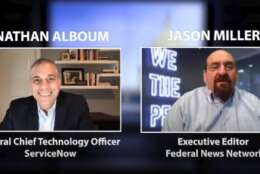Carahsoft
-
About a third of all cyber incidents federal agencies faced last year were unknown or outside the typical spam, phishing or web authentication vectors. The Office of Management and Budget says the prevalence of this attack vector suggests additional steps should be taken to ensure agencies appropriately categorize the vector of incidents during reporting.
September 17, 2021 -
This exclusive e-book highlights the efforts today and what’s on the horizon by civilian and the military services in rolling out 5G infrastructure and devices to improve mission effectiveness
September 10, 2021 -
To combat the ever-increasing cyber threats, agencies are spending more money than ever. But it’s more than just money that is needed. It’s also people and better data.
August 31, 2021 -
2020 was the first time in history the U.S. Census included an option to respond online. Wanting to find ways to encourage engagement, the U.S. Census Bureau created a public-facing map of responses by neighborhood…
August 05, 2021 -
Matt Mandrgoc, the head of US public sector at Zoom, said the pandemic showed three things: Incumbent technologies were not necessarily scalable to satisfy the needs of the mass remote work environment; the culture change brought on by mass telework will be permanent; and cloud services were critical to all of these successes.
July 30, 2021 -
Sudhakar Ramakrishna, the president and CEO at SolarWinds, said the high-profile attack his company experienced, which came to light in December but likely started a year before, is both a learning experience and an opportunity to double-down on software development approaches.
June 07, 2021 -
John Fanguy, the federal chief technology officer for cybersecurity at Micro Focus Government Solutions, said agencies can prepare for the next cyber attack and ensure their missions are resilient by taking several important steps, starting with implementing Trusted Internet Connections (TIC) 3.0.
May 07, 2021 -
Cloud Smart is about putting data “where it is of most value and also where it’s most accessible and usable from a performance perspective,” Krejcik said during an interview on Innovation in Government, a show sponsored by Carahsoft. Manage your data, manage your workload.
April 02, 2021 -
Jonathan Alboum, the principal digital strategist for federal at ServiceNow, said agency managers can start preparing today for the future when employees return to the office with a goal of ensuring their safety through the use of technology and data.
February 24, 2021 -
Phoebe Nerdahl, the public sector lead for Atlassian, said there technology, tools process steps agencies can take to continue this evolution.
January 22, 2021 -
Dan Carayiannis, the director of public sector at RSA, said the increasing concern about technology products and components, and whether the technology suppliers understand and have transparency into the chain of custody created a wake-up call of sorts for public and private sector organizations.
December 14, 2020 -
Jeffrey Phelan, the chief technology officer for public sector at Rubrik, said while it’s clear every agency is at a different point in corralling their data, too often they are in “deer in the headlights” mode.
November 24, 2020 -
Dean Hullings, the global defense solutions strategist for Forescout Technologies, said the goals of the comply-to-connect program was to close the gaps of existing security tools and make existing security processes more efficient for network administrators.
October 29, 2020 -
This panel explores the range of data practices and strategies needed for today’s policy and compliance environment.
October 27, 2020 -
About RSA RSA, a leader in cybersecurity and risk management solutions, provides organizations with technology to address challenges across security, risk management and fraud prevention in the digital era. RSA solutions are designed to…
October 26, 2020















